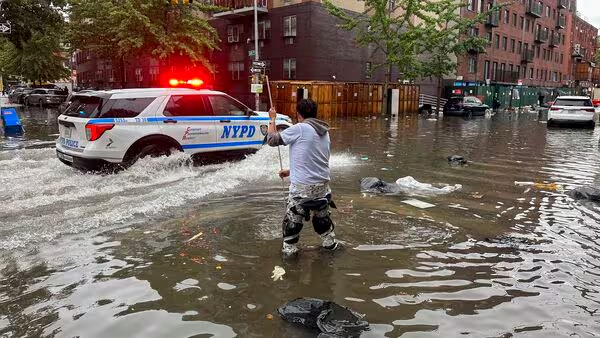On the night of July 14, 2025, torrential rains unleashed chaos across the New York City metropolitan area, triggering flash floods that claimed two lives, paralyzed public transit, and left communities scrambling to recover. The storms, which dumped up to 6.67 inches of rain in some areas, exposed the region’s aging infrastructure and its vulnerability to extreme weather fueled by climate change.
A Night of Chaos
The deluge began Monday evening, with heavy rain falling at a staggering rate—Central Park recorded over 2 inches in a single hour, the second-wettest hour in the city’s history. Flash flood warnings blanketed the region, extending into northern New Jersey, where Gov. Phil Murphy declared a state of emergency. In Plainfield, New Jersey, tragedy struck when a car was swept into Cedar Brook, killing two women inside. “I’m shocked,” said Laura Lewis, a local resident. “That brook is normally just a trickle of water.”
In New York City, subway stations became scenes of chaos. At the 28th Street station in Manhattan, water gushed from a drain, soaking the platform. At 34th Street-Penn Station, commuters tiptoed around pooling water. The Metropolitan Transportation Authority (MTA) suspended service on multiple lines, including the 1, 2, 3, and 6, as floodwaters inundated tracks. Metro-North Railroad and NJ Transit also faced delays, with some Amtrak trains canceled. “The system is not a hermetically sealed submarine,” said MTA Chair Janno Lieber, who praised workers for restoring service by Tuesday morning.
Roads and Rescues
Floodwaters turned roads into rivers. In Scotch Plains, New Jersey, vehicles like an ambulance and a UPS truck stalled in high water on Main Street. A rescue team used a frontloader to save stranded residents. Park Avenue was completely submerged, and Route 22 and Route 28 in Somerset and Middlesex Counties buckled under the strain, with debris and abandoned cars clogging lanes. In Westchester County, New York, the Bronx River Parkway and other roads flooded “very, very quickly,” said County Executive Ken Jenkins, prompting numerous 911 calls and rescues by local fire departments.
Rockland County saw similar scenes, with a parking lot at Rockland Plaza in Nanuet underwater and a school bus narrowly avoiding flooded roads in Spring Valley. In Harlem, a falling tree branch injured a pedestrian, breaking both of his legs, while in North Plainfield, a house exploded due to a gas leak amid the flooding, though no one was hurt.
Infrastructure Under Pressure
The storms underscored a harsh reality: the region’s infrastructure is no match for increasingly intense weather. New York City’s subway and sewer systems, both over a century old, were designed for a milder climate. The sewer system, built for 1.75 inches of rain, was overwhelmed by Monday’s downpour. “The pipes were designed for a certain amount of water,” said Rohit Aggarwala, the city’s chief climate officer. “A lot more water fell from the sky.” Upgrading the sewers could cost $30 billion, but with only $1 billion budgeted annually, meaningful fixes could take decades.
The subway’s porous design—39,000 air vents, open grates, and station entrances—makes it prone to flooding. The MTA has plans for automatic vent closures and requests $6 billion for flood resilience, but progress is slow. “It’s not just an MTA issue,” said geophysicist Klaus Jacob. “The flash flooding has to do with insufficient drainage, and that’s a city issue.”
A Community Hit Hard
In Scotch Plains, Lisa Mohn, owner of the Apple Blossom flower shop, faced a grim cleanup. “The smell when I opened the basement was overpowering,” she said, describing mud-caked floors and ruined carpets. In Plainfield, the Area Humane Society was devastated by floodwaters, though staff heroically saved all animals. The shelter now desperately needs donations for food and supplies.
Looking Ahead
As the region dried out on Tuesday, July 15, 2025, forecasters warned of more rain from Delaware to South Carolina. New Jersey Gov. Phil Murphy, touring the damage in Berkeley Heights, linked the destruction to climate change, saying, “We are getting dragged by climate.” New York City Mayor Eric Adams echoed this, noting that the city’s outdated sewers can’t handle such intense storms.
For residents like Laura Lewis, who now keeps an emergency bag packed, the floods are a stark reminder of a changing climate. “With the way climate change is going, this is definitely going to happen again,” she said. As the region rebuilds, the question looms: can it adapt before the next storm hits?
